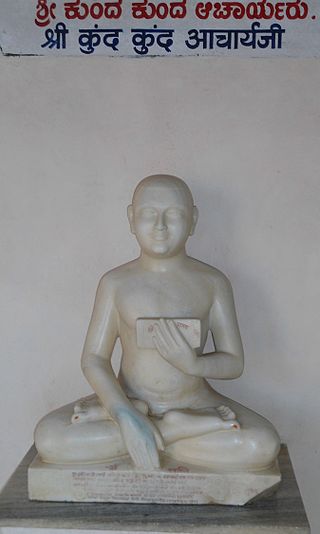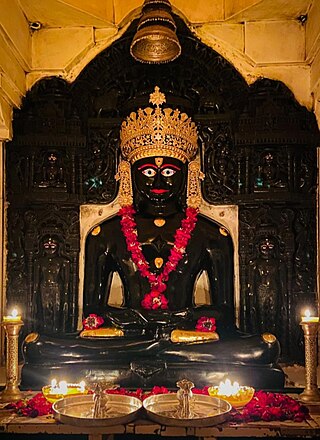
Mahavira, also known as Vardhamana, was the 24th Tirthankara of Jainism. He was the spiritual successor of the 23rd Tirthankara Parshvanatha. Mahavira was born in the early 6th century BCE into a royal Jain family of ancient India. His mother's name was Trishala and his father's name was Siddhartha. They were lay devotees of Parshvanatha. Mahavira abandoned all worldly possessions at the age of about 30 and left home in pursuit of spiritual awakening, becoming an ascetic. Mahavira practiced intense meditation and severe austerities for twelve and a half years, after which he attained Kevala Jnana (omniscience). He preached for 30 years and attained moksha (liberation) in the 6th century BCE, although the year varies by sect.

Mahavir Janma Kalyanak is one of the most important religious festivals in Jainism. It celebrates the birth of Mahavira, the twenty-fourth and last Tirthankara of present Avasarpiṇī. On the Gregorian calendar, the holiday occurs either in March or April.

The Śvētāmbara is one of the two main branches of Jainism, the other being the Digambara. Śvētāmbara means "white-clad", and refers to its ascetics' practice of wearing white clothes, which sets it apart from the Digambara "sky-clad" Jains, whose ascetic practitioners go nude. Śvētāmbaras do not believe that ascetics must practice nudity.

Siddhartha was the father of Mahavira (Vardhamana), the 24th Jain Tirthankara. He was a Kshatriya King from the Ikshvaku dynasty and the ruler of the Nata, Ainwar (Light), Gyat or Jnatri clan in Kshatriya Kundagrama, a suburb of Vaishali. He was married to Licchavi princess Trishala.

Parshvanath, also Pārśvanātha, Parshva, Pārśva and Parasnath, was the 23rd of 24 Tirthankaras of Jainism. He gained the title of Kalīkālkalpataru.

Ācārya Bhadrabāhu was, according to the Digambara sect of Jainism, the last Shruta Kevalin in Jainism. He was the last acharya of the undivided Jain sangha. He was the spiritual teacher of Chandragupta Maurya, the founder of the Maurya Empire.

Jain monasticism refers to the order of monks and nuns in the Jain community and can be divided into two major denominations: the Digambara and the Śvētāmbara. The monastic practices of the two major sects vary greatly, but the major principles of both are identical. Five mahāvratas, from Mahavira's teachings, are followed by all Jain ascetics. Historians believe that a united Jain sangha (community) existed before 367 BCE, about 160 years after the moksha (liberation) of Mahavira. The community then gradually divided into the major denominations.

Munisuvrata or Munisuvratanatha was the twentieth Tirthankara of the present half time cycle (avasarpini) in Jain cosmology. He became a siddha, a liberated soul which has destroyed all of his karma. Events of the Jaina version of Ramayana are placed at the time of Munisuvrata. Munisuvrata lived for over 30,000 years. His chief apostle (gaṇadhara) was sage Malli Svāmi.

Neminātha, also known as Nemi and Ariṣṭanemi, is the twenty-second Tīrthaṅkara of Jainism in the present age. Neminatha lived 81,000 years before the 23rd Tirthankara Parshvanatha. According to traditional accounts, he was born to King Samudravijaya and Queen Shivadevi of the Yadu dynasty in the north Indian city of Sauripura. His birth date was the fifth day of Shravana Shukla of the Jain calendar. Krishna, who was the 9th and last Jain Vasudev, was his first cousin.
Jainism is a religion founded in ancient India. Jains trace their history through twenty-four tirthankara and revere Rishabhanatha as the first tirthankara. The last two tirthankara, the 23rd tirthankara Parshvanatha and the 24th tirthankara Mahavira are considered historical figures. According to Jain texts, the 22nd tirthankara Neminatha lived about 5,000 years ago and was the cousin of Krishna.
Jain literature refers to the literature of the Jain religion. It is a vast and ancient literary tradition, which was initially transmitted orally. The oldest surviving material is contained in the canonical Jain Agamas, which are written in Ardhamagadhi, a Prakrit language. Various commentaries were written on these canonical texts by later Jain monks. Later works were also written in other languages, like Sanskrit and Maharashtri Prakrit.
According to the Jain cosmology, the Śalākāpuruṣa "illustrious or worthy persons" are 63 illustrious beings who appear during each half-time cycle. They are also known as the triṣaṣṭiśalākāpuruṣa. The Jain universal or legendary history is a compilation of the deeds of these illustrious persons. Their life stories are said to be most inspiring.

Digambara is one of the two major schools of Jainism, the other being Śvētāmbara (white-clad). The Sanskrit word Digambara means "sky-clad", referring to their traditional monastic practice of neither possessing nor wearing any clothes.

Jainism is an Indian religion which is traditionally believed to be propagated by twenty-four spiritual teachers known as tirthankara. Broadly, Jainism is divided into two major schools of thought, Digambara and Svetambara. These are further divided into different sub-sects and traditions. While there are differences in practices, the core philosophy and main principles of each sect is the same.

Jain art refers to religious works of art associated with Jainism. Even though Jainism has spread only in some parts of India, it has made a significant contribution to Indian art and architecture.

Auspicious dreams are often described in texts of Jainism which forecast the virtue of children. Their number varies according to different traditions and they described frequently as fourteen or sixteen dreams. They are seen by mothers of the prominent figures in Jainism including Tirthankaras, on the conception of their soul in the womb. They are interpreted as describing virtues and kingship of a future child. They are also found in various artistic media as an ornamentation.

Kundalpur is a village in Nalanda district in the Indian state of Bihar. It is located about 2.5 kilometres from ancient Nalanda Mahavihara, 11 kilometres southwest of Bihar Sharif, and 80 kilometres southeast of Patna.

Naigamesha, also known as Harinegameshi, is a goat-headed or deer-headed deity, associated with children. He also appears in Jain as well as Hindu traditions, associated with the war-god Kartikeya and childbirth.
Jain festivals occur on designated days of the year. Jain festivals are either related to life events of Tirthankara or they are performed with intention of purification of soul.

Samantabhadra was a Digambara acharya who lived about the later part of the second century CE. He was a proponent of the Jaina doctrine of Anekantavada. The Ratnakaranda śrāvakācāra is the most popular work of Samantabhadra. Samantabhadra lived after Umaswami but before Pujyapada.

















